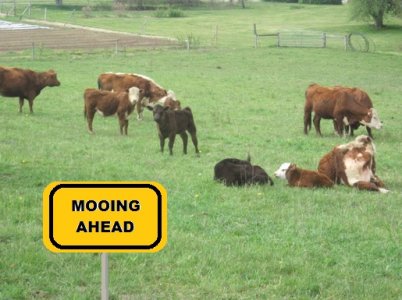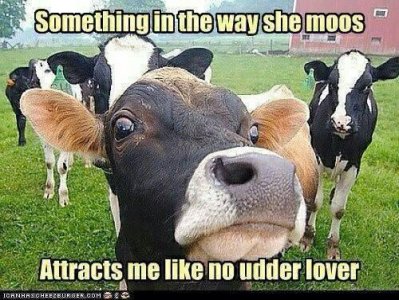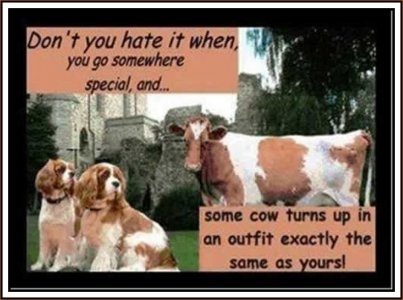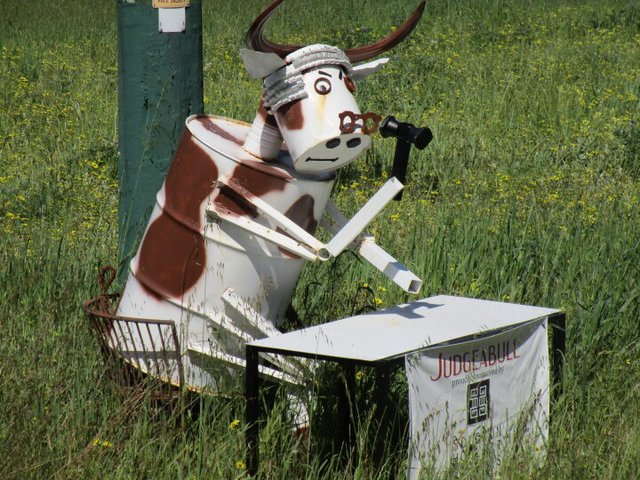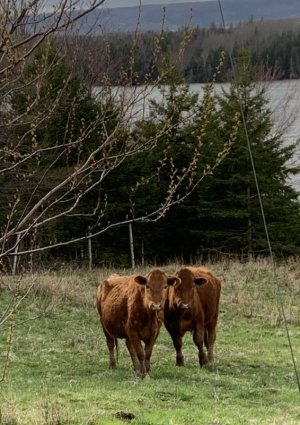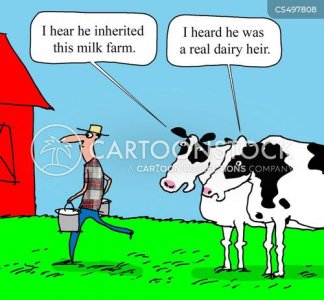Those days on the farm turned out to be the best days of my life to that point. I learned not only stuff about farming, but also about life, teamwork and people. Those were good days. People that earn their living by farmimg are good, honest and hard working people. They do right by their animals. Not all farmers do, but most.
You are using an out of date browser. It may not display this or other websites correctly.
You should upgrade or use an alternative browser.
You should upgrade or use an alternative browser.
The cow thread
- Thread starter ronaldj
- Start date
Bretrick
Well-known Member
- Location
- Perth Western Australia
An historic cow survival story from Australia.
Taken from The Courier Mail, Queensland
Feb 21 2011.
Danette is the Murray Grey cow that survived an epic 95km swim during the January floods.
After being swept away by the torrent that raged through the small property owned by Veronica Nutley, at Patrick Estate, near Lowood in the Brisbane Valley, on Tuesday, January 11, Danette was found three days later bobbing at the mouth of the Brisbane River near Luggage Point.
It was bovine bravado of an extreme level, even outstripping the remarkable 87km journey of a Brahman bull named Barney who ping-ponged his way down the Tweed River and somehow survived in floods three years ago.
Volunteers from the Cabbage Tree Creek rescue group found Danette and towed her to shore after her marathon journey, in which she somehow dodged the currents, sunken obstacles and sharks.
For awed youngsters in the Brisbane Valley, fairytales such as The Cow That Jumped Over the Moon have been replaced by the real-life drama of The Cow That Swam Through The Monsoon.
Brisbane council workers used the tag inside Danette's ear to identify her, but were still in a state of confusion about how she got there when they rang her owner.
``The man phoned and said they had one of my cows and was she stolen,'' Ms Nutley said.
``He said, `We picked her up at the entrance of the river . . . how did she get there?' and I said, `Mate . . . she swam'.
``He refused to believe me and said, `That's not possible'. But I said, `I'm telling you, she swam'. I am not sure how she did it, but they say cows' stomachs can bloat and that helps them float when something like this happens.''
Veronica says cows have specific personalities and those in Danette's line are ``full of themselves''.
``She made it all that way and I can't help but wonder where the others are,'' Ms Nutley said. ``We had eight cows and she was the only one we located. The others all had tags.''
Danette is a show cow who last year won a third prize at the Brisbane Exhibition; locals quip she is so tough that this year she may enter the wood chop.
Ms Nutley believes Danette floated through Lowood, then into Lockyer Creek and finally into the Brisbane River where she would have bobbed through the CBD on her way to Luggage Point.
Ms Nutley says things could have been worse for Danette.
``There was another cow that battled the floods that finally found dry land and walked into the yard at the meatworks at Dinmore,'' she said.
``I am very grateful Danette is smarter than that.''
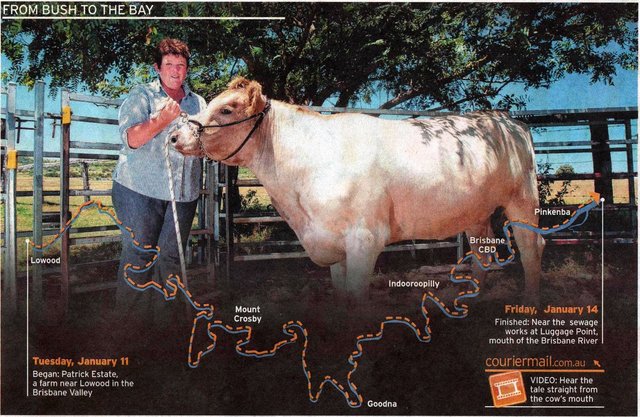
Taken from The Courier Mail, Queensland
Feb 21 2011.
Danette is the Murray Grey cow that survived an epic 95km swim during the January floods.
After being swept away by the torrent that raged through the small property owned by Veronica Nutley, at Patrick Estate, near Lowood in the Brisbane Valley, on Tuesday, January 11, Danette was found three days later bobbing at the mouth of the Brisbane River near Luggage Point.
It was bovine bravado of an extreme level, even outstripping the remarkable 87km journey of a Brahman bull named Barney who ping-ponged his way down the Tweed River and somehow survived in floods three years ago.
Volunteers from the Cabbage Tree Creek rescue group found Danette and towed her to shore after her marathon journey, in which she somehow dodged the currents, sunken obstacles and sharks.
For awed youngsters in the Brisbane Valley, fairytales such as The Cow That Jumped Over the Moon have been replaced by the real-life drama of The Cow That Swam Through The Monsoon.
Brisbane council workers used the tag inside Danette's ear to identify her, but were still in a state of confusion about how she got there when they rang her owner.
``The man phoned and said they had one of my cows and was she stolen,'' Ms Nutley said.
``He said, `We picked her up at the entrance of the river . . . how did she get there?' and I said, `Mate . . . she swam'.
``He refused to believe me and said, `That's not possible'. But I said, `I'm telling you, she swam'. I am not sure how she did it, but they say cows' stomachs can bloat and that helps them float when something like this happens.''
Veronica says cows have specific personalities and those in Danette's line are ``full of themselves''.
``She made it all that way and I can't help but wonder where the others are,'' Ms Nutley said. ``We had eight cows and she was the only one we located. The others all had tags.''
Danette is a show cow who last year won a third prize at the Brisbane Exhibition; locals quip she is so tough that this year she may enter the wood chop.
Ms Nutley believes Danette floated through Lowood, then into Lockyer Creek and finally into the Brisbane River where she would have bobbed through the CBD on her way to Luggage Point.
Ms Nutley says things could have been worse for Danette.
``There was another cow that battled the floods that finally found dry land and walked into the yard at the meatworks at Dinmore,'' she said.
``I am very grateful Danette is smarter than that.''

Bretrick
Well-known Member
- Location
- Perth Western Australia
Some interesting facts about cows. (taken from Animals Australia)
They are individuals, no two cows are alike. Some are bold, some timid, some curious, some affectionate.
From a young age, calves each react very differently to stimuli in their surroundings — reflecting their individual likes, dislikes and personality.
They're smart. Cows can solve puzzles. What’s more, they enjoy it! When they work out the solution to a problem, one study found that young heifers would get excited, some even jumping into the air — seemingly in celebration of their Eureka moment. Researchers are finding that cattle are far more intelligent than people give them credit for – and may actually possess heightened brain function and decision-making abilities.
They have best friends. In fact, they’re quite the socialites. They seek out and nurture relationships with other individuals in the herd — often forming cooperative grooming partnerships. When separated from their best buddy, they become stressed.
They have leaders. What do cows look for in a leader? Much the same things as us. Studies have suggested that intelligence, inquisitiveness, confidence, experience and good social skills all help to determine who will become the leader within a herd.
They are loving and protective mothers.
Like humans, a mother cow and her calf share a strong and special bond — one that can form within minutes of birth. When mother cows and their calves are left to live a natural life, the calf will suckle from his mother for several months, even up to a year. Research has shown that adult cows remain deeply affected by the emotional pain of being separated as calves from their mothers, which is standard practice in the dairy industry.
Their kids are kind of like ours.
In all the best ways, calves are a lot like kids! They’re cheeky, and super playful. When they want to play, they will signal to each other with their tails and a special call — so that it’s clear they mean no harm when mimicking the behaviour of adult cattle.
They enjoy music.
Researchers now believe that music with a slow tempo reduces cows’ stress levels. It seems that jazz isn't off the play list just yet either though …
They are individuals, no two cows are alike. Some are bold, some timid, some curious, some affectionate.
From a young age, calves each react very differently to stimuli in their surroundings — reflecting their individual likes, dislikes and personality.
They're smart. Cows can solve puzzles. What’s more, they enjoy it! When they work out the solution to a problem, one study found that young heifers would get excited, some even jumping into the air — seemingly in celebration of their Eureka moment. Researchers are finding that cattle are far more intelligent than people give them credit for – and may actually possess heightened brain function and decision-making abilities.
They have best friends. In fact, they’re quite the socialites. They seek out and nurture relationships with other individuals in the herd — often forming cooperative grooming partnerships. When separated from their best buddy, they become stressed.
They have leaders. What do cows look for in a leader? Much the same things as us. Studies have suggested that intelligence, inquisitiveness, confidence, experience and good social skills all help to determine who will become the leader within a herd.
They are loving and protective mothers.
Like humans, a mother cow and her calf share a strong and special bond — one that can form within minutes of birth. When mother cows and their calves are left to live a natural life, the calf will suckle from his mother for several months, even up to a year. Research has shown that adult cows remain deeply affected by the emotional pain of being separated as calves from their mothers, which is standard practice in the dairy industry.
Their kids are kind of like ours.
In all the best ways, calves are a lot like kids! They’re cheeky, and super playful. When they want to play, they will signal to each other with their tails and a special call — so that it’s clear they mean no harm when mimicking the behaviour of adult cattle.
They enjoy music.
Researchers now believe that music with a slow tempo reduces cows’ stress levels. It seems that jazz isn't off the play list just yet either though …
RadishRose
SF VIP
- Location
- Connecticut, USA
Bretrick
Well-known Member
- Location
- Perth Western Australia
Police are probing how a heavy cow statue ended up on a servo roof in Perth.
The animal was stolen from primary school students and somehow ended up in the unusual spot in the city's south east.
Byford residents woke to find the fibreglass heifer on top of the Vibe service station.
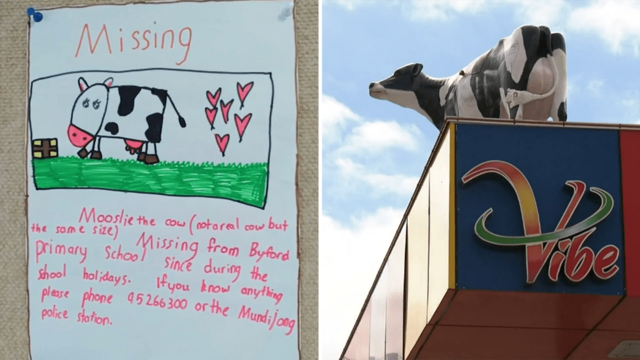
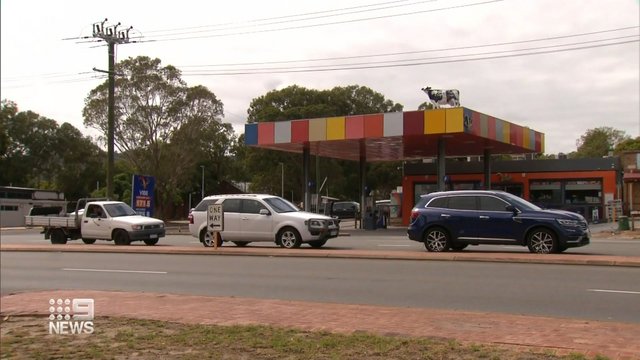
They thought it was a late April Fools joke, but were not sure how the culprits got the creature - Byford Primary's beloved missing 'Mooslie' - up there.
It took a team-effort by the close-knit community to get the beloved bovine down, with the help of a cherry picker.
School officials say 'Mooslie' was stolen from the Byford Primary School memorial garden last year, and they've been looking for her ever since, even making 'missing' posters.
The animal was stolen from primary school students and somehow ended up in the unusual spot in the city's south east.
Byford residents woke to find the fibreglass heifer on top of the Vibe service station.


They thought it was a late April Fools joke, but were not sure how the culprits got the creature - Byford Primary's beloved missing 'Mooslie' - up there.
It took a team-effort by the close-knit community to get the beloved bovine down, with the help of a cherry picker.
School officials say 'Mooslie' was stolen from the Byford Primary School memorial garden last year, and they've been looking for her ever since, even making 'missing' posters.
Bretrick
Well-known Member
- Location
- Perth Western Australia
Orphaned brumby foal adopts Brahman cow as it's mother.
A Brahman cow has embraced motherhood by adopting an orphaned brumby foal on a far north Queensland cattle station.
The wild foal was noticed by Mount Garnet grazier Rob O'Shea around the cattle herd on his Tablelands property after its mother died.
"I saw a cow looking after it," Mr O'Shea said.
"The little foal was sucking the cow … I've never seen that in my life before."
The cow had never calved, according to Mr O'Shea, but it was content to take on the role of stepmother.
The foal has been welcomed into the herd.
"Now she sleeps with all the calves," Mr O'Shea said.
"It whinnies to the cow and the cow bellows and answers it.
"She bathes it and she's made a real mother of it."
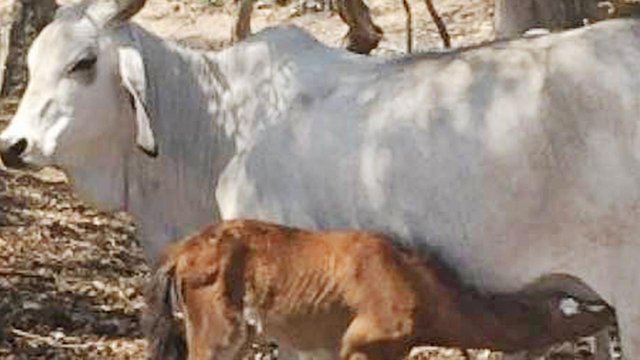
A Brahman cow has embraced motherhood by adopting an orphaned brumby foal on a far north Queensland cattle station.
The wild foal was noticed by Mount Garnet grazier Rob O'Shea around the cattle herd on his Tablelands property after its mother died.
"I saw a cow looking after it," Mr O'Shea said.
"The little foal was sucking the cow … I've never seen that in my life before."
The cow had never calved, according to Mr O'Shea, but it was content to take on the role of stepmother.
The foal has been welcomed into the herd.
"Now she sleeps with all the calves," Mr O'Shea said.
"It whinnies to the cow and the cow bellows and answers it.
"She bathes it and she's made a real mother of it."

What a heart-warming storyOrphaned brumby foal adopts Brahman cow as it's mother.
A Brahman cow has embraced motherhood by adopting an orphaned brumby foal on a far north Queensland cattle station.
The wild foal was noticed by Mount Garnet grazier Rob O'Shea around the cattle herd on his Tablelands property after its mother died.
"I saw a cow looking after it," Mr O'Shea said.
"The little foal was sucking the cow … I've never seen that in my life before."
The cow had never calved, according to Mr O'Shea, but it was content to take on the role of stepmother.
The foal has been welcomed into the herd.
"Now she sleeps with all the calves," Mr O'Shea said.
"It whinnies to the cow and the cow bellows and answers it.
"She bathes it and she's made a real mother of it."

Bretrick
Well-known Member
- Location
- Perth Western Australia
I like to find uplifting stories to share with members.What a heart-warming story
PeppermintPatty
🐢. 🐳. 🐢
- Location
- Canada
I agree!Those days on the farm turned out to be the best days of my life to that point. I learned not only stuff about farming, but also about life, teamwork and people. Those were good days. People that earn their living by farmimg are good, honest and hard working people. They do right by their animals. Not all farmers do, but most.
Good wholesome living.
debodun
SF VIP
- Location
- way upstate in New York, USA
Years ago, there was a meat market in a nearby town. On the roof was a life-sized figure of a bull. People were offended because it was "anatomically correct" and the market was forced to remove it. It is mentioned at the end of the owners obituary:
https://dailygazette.com/2011/04/26/427_butcher/
https://dailygazette.com/2011/04/26/427_butcher/
debodun
SF VIP
- Location
- way upstate in New York, USA
debodun
SF VIP
- Location
- way upstate in New York, USA
Mizmo
Well-known Member
- Location
- Ontario, Canada
Bretrick
Well-known Member
- Location
- Perth Western Australia
Been There
Well-known Member
- Location
- Florida
I grew up on a small farm. We raised some beef cattle for area residents that bought the meat. We had some dairy cows, but not a lot. Gramps wanted just enough so we could get about 100 gallons of milk per day as a cash crop. At that time, we did pretty good because our cows were young. A few were first timers at having a calf. Our little farm paid the bills with some cash leftover to put away for a rainy day.
PeppermintPatty
🐢. 🐳. 🐢
- Location
- Canada
Wayne
Senior Member
Bretrick
Well-known Member
- Location
- Perth Western Australia
Bull breaks auction record, selling for more than a country town home
A 12-month-old Angus bull has become the most expensive ever sold in Australia — for $360,000.The 12-month-old bull is the second-most-expensive beef animal ever traded in Australia, coming in behind a $400,000 Wagyu heifer sold last year.
"The opening bid was $10,000, then it went to $100,000 and we’re going 'Oh my God, this is alright', then it went to $200,000.
"In the crowd there must have been 150 phones on video and the [bidding] kept on going … it was the most incredible thing to witness, and it happened to us."
The sale breaks the former Australian bull record of $325,000 set by a Brahman in 2017.
Texas THUNDERSTRUCK T383 - Lot 49
Bretrick
Well-known Member
- Location
- Perth Western Australia
I Am Not Here To Flirt Or Date.
Simply to tell you all that finally there is a matchmaking site for lonely Cattle.
Tudder is a dating app for Cows that has a much greater success rate that it's human equivalent, Tinder.
United Kingdom farming startup, Hectare Agritech, has created Tudder that helps farmers find breeding matches by viewing pictures of cattle with details of their age, location and owner.
Simply to tell you all that finally there is a matchmaking site for lonely Cattle.
Tudder is a dating app for Cows that has a much greater success rate that it's human equivalent, Tinder.
United Kingdom farming startup, Hectare Agritech, has created Tudder that helps farmers find breeding matches by viewing pictures of cattle with details of their age, location and owner.
Bretrick
Well-known Member
- Location
- Perth Western Australia
Bull calf ratios take NSW (Australia) Angus cattle stud by surprise as male calf births far outweigh heifers.
Farmers report a surge in bull calves born in northern NSW, while southern farmers say they're seeing more heifers.
Ms Halliday and her husband, Stuart, run a fifth-generation stud, Ben Nevis Angus, near Walcha.
The farm sometimes sees a 60:40 ratio of bull calves to heifers, but so far this season it's more like 87:13.
"With my heifers so far in my first round of artificial insemination, I have got 53 calves on the ground of which 46 are bull calves and six are heifers," Ms Halliday said.
"I'm just going to cross my fingers and touch wood but I have heard it is a sign of drought and that it's nature's way of making sure we don't have lots of young cows with calves on the ground when a drought hits in the future," she said.
Others have suggested the ratio imbalance may be due to the timing of artificial insemination (AI).
"About 75 per cent of these [calves] are from a fixed-time AI program and there is a lot of talk about timing there," she said.
So is it nature, science or both that could be contributing to the high number of bull calves?
Udo Mahne is an embryo transfer vet at Glen Innes.
He said both science and nature could influence the gender of calves.
"If there is a heat wave or a big change in the weather, then it actually stresses us physically and it will bring up certain factors that will change the way sperm cells are made or [how they are] surviving in the ******* tract of a female," he said.
"If the environment changes, it has an effect on the female egg cell and she has the ability to read signals from the male sperm cell and say, 'Oh I think I would rather have a male this time.'"
Farmers report a surge in bull calves born in northern NSW, while southern farmers say they're seeing more heifers.
Ms Halliday and her husband, Stuart, run a fifth-generation stud, Ben Nevis Angus, near Walcha.
The farm sometimes sees a 60:40 ratio of bull calves to heifers, but so far this season it's more like 87:13.
"With my heifers so far in my first round of artificial insemination, I have got 53 calves on the ground of which 46 are bull calves and six are heifers," Ms Halliday said.
"I'm just going to cross my fingers and touch wood but I have heard it is a sign of drought and that it's nature's way of making sure we don't have lots of young cows with calves on the ground when a drought hits in the future," she said.
Others have suggested the ratio imbalance may be due to the timing of artificial insemination (AI).
"About 75 per cent of these [calves] are from a fixed-time AI program and there is a lot of talk about timing there," she said.
So is it nature, science or both that could be contributing to the high number of bull calves?
Udo Mahne is an embryo transfer vet at Glen Innes.
He said both science and nature could influence the gender of calves.
"If there is a heat wave or a big change in the weather, then it actually stresses us physically and it will bring up certain factors that will change the way sperm cells are made or [how they are] surviving in the ******* tract of a female," he said.
"If the environment changes, it has an effect on the female egg cell and she has the ability to read signals from the male sperm cell and say, 'Oh I think I would rather have a male this time.'"
Bretrick
Well-known Member
- Location
- Perth Western Australia
Some more cow facts
- Cows have with a visual field of 330° almost an all-around view. They can see the colours yellow, green and blue whereas red is hard to see for them
- The natural life expectancy of a cow is around twenty years. Some get up to 25 years old. The age of a cow can be determined by looking at its teeth. the number of rings in its horns draws conclusions about the age.
- Cows don’t need much sleep. Per day they only sleep around 30 minutes in deep sleep that is divided in 6-10 short periods. Nevertheless, the are lying down for up to 10 hours daily.
- Cows have a strong sense of smell. They can perceive smells at a distance of up to ten kilometres.
- Compared to the hearing of humans, the hearing ability of cows is better in the deep and high frequency ranges.
- Cows are moving constantly during grazing and can cover 13 km per day.
- Cows are very social animals. They live in small herds of 20-30 animals and form close friendships with other animals in their herd. Licking each other reinforces relationships between the animals and has a relaxing effect.
- Cows drink daily up to 100 litres. That almost complies with a whole bathtub of water.
- Pregnancy lasts nine months, just like with human beings. Cows only give milk when they have a calf.
- Besides 'mooing', cows use their body language, such as the position of the head, limbs and tail, as well as facial expressions, as a form of communication
- Cows have with a visual field of 330° almost an all-around view. They can see the colours yellow, green and blue whereas red is hard to see for them
- The natural life expectancy of a cow is around twenty years. Some get up to 25 years old. The age of a cow can be determined by looking at its teeth. the number of rings in its horns draws conclusions about the age.
- Cows don’t need much sleep. Per day they only sleep around 30 minutes in deep sleep that is divided in 6-10 short periods. Nevertheless, the are lying down for up to 10 hours daily.
- Cows have a strong sense of smell. They can perceive smells at a distance of up to ten kilometres.
- Compared to the hearing of humans, the hearing ability of cows is better in the deep and high frequency ranges.
- Cows are moving constantly during grazing and can cover 13 km per day.
- Cows are very social animals. They live in small herds of 20-30 animals and form close friendships with other animals in their herd. Licking each other reinforces relationships between the animals and has a relaxing effect.
- Cows drink daily up to 100 litres. That almost complies with a whole bathtub of water.
- Pregnancy lasts nine months, just like with human beings. Cows only give milk when they have a calf.
- Besides 'mooing', cows use their body language, such as the position of the head, limbs and tail, as well as facial expressions, as a form of communication
Bretrick
Well-known Member
- Location
- Perth Western Australia
Anna Creek – The Biggest Cattle Station in Australia
Anna Creek is not only Australia's biggest cattle station; it's the largest in the world.The station covers a total of around 24,000 sq kms.
When you consider that the country of Israel is only 21,000 sq km in size, you realise how vast this station is.
It is 7 times larger than the biggest ranch in the US which is 3338 sq km - King Ranch in Southern Texas - (35,000 head) and is far bigger than the other largest Australian cattle stations which are:
Clifton Hills Station – 17,000 square kilometres.
Alexandria Station – 16,116 square kilometres.
Davenport Downs Station – 15,100 square kilometres.
You can see by these figures that all Australian cattle stations tend to be large. This is due to them being located in a dry climate. This means that the amount of vegetation available can be limited.
Therefore, stations need to contain a large amount of country so that there is enough vegetation to support even an average number of cattle.
Currently, there are less than 10,000 head of cattle at the station but there have been as many as 17,000 in a good season.
The property was originally established in 1863 but moved to its current location in 1872. It was originally used for sheep, but due to losses from dingo attacks, they switched to cattle.
Once there was a large workforce of stockmen at Anna Creek, who mustered the cattle on horses. Today light aircraft are used for spotting animals which are rounded up by stockmen riding motorbikes, requiring a much smaller workforce.






